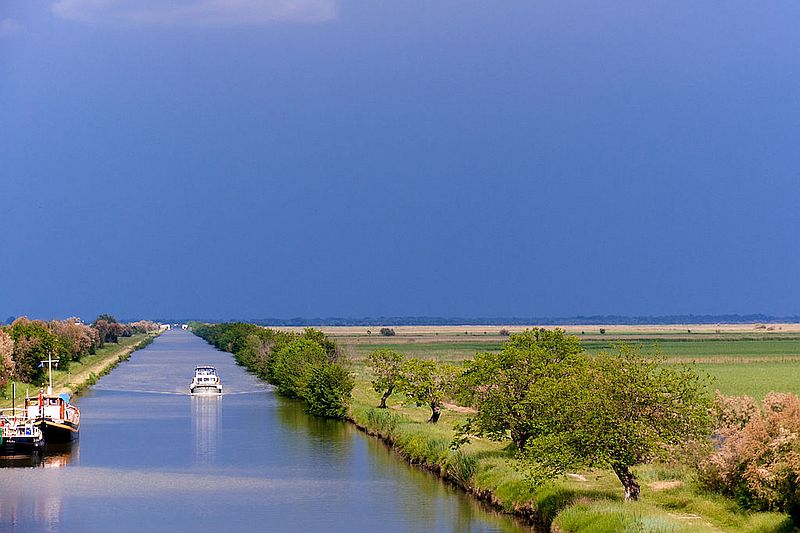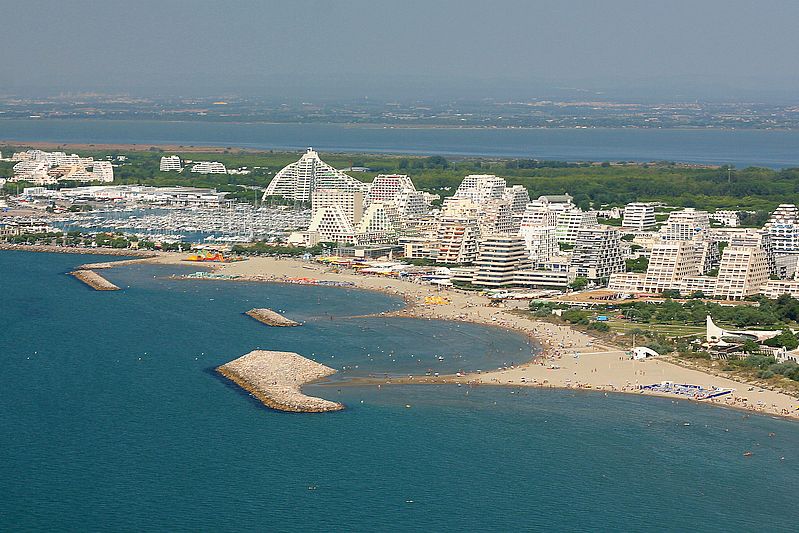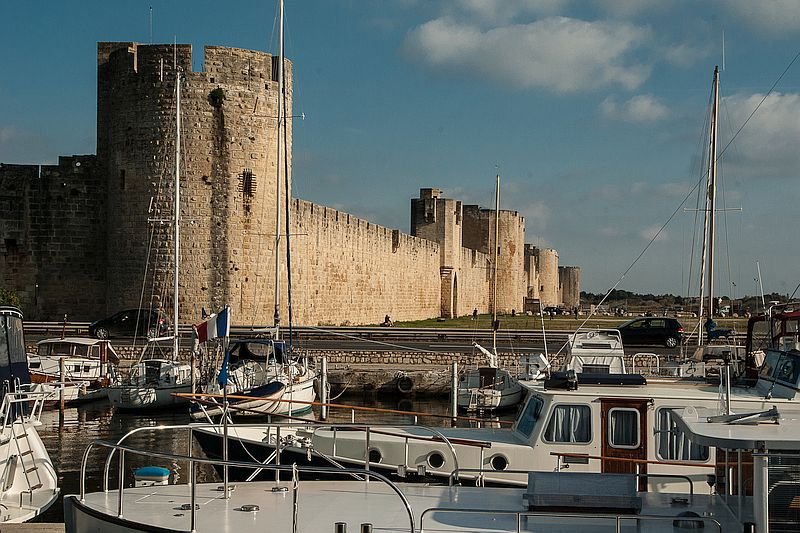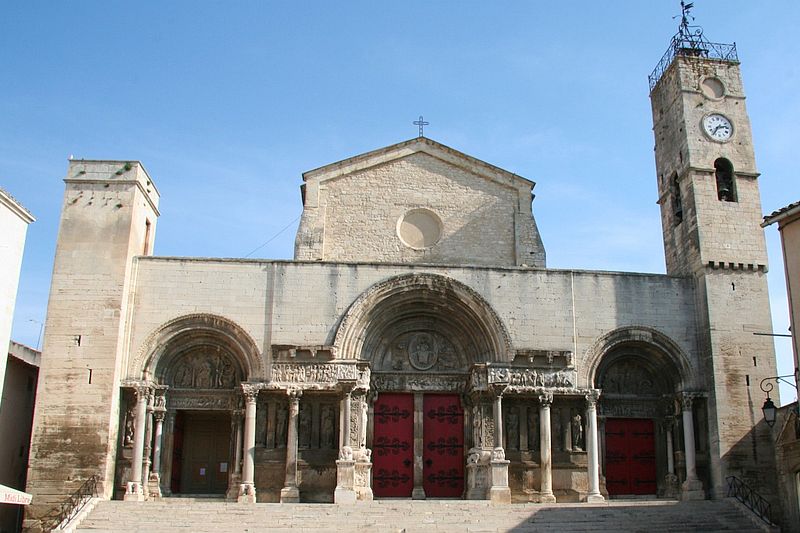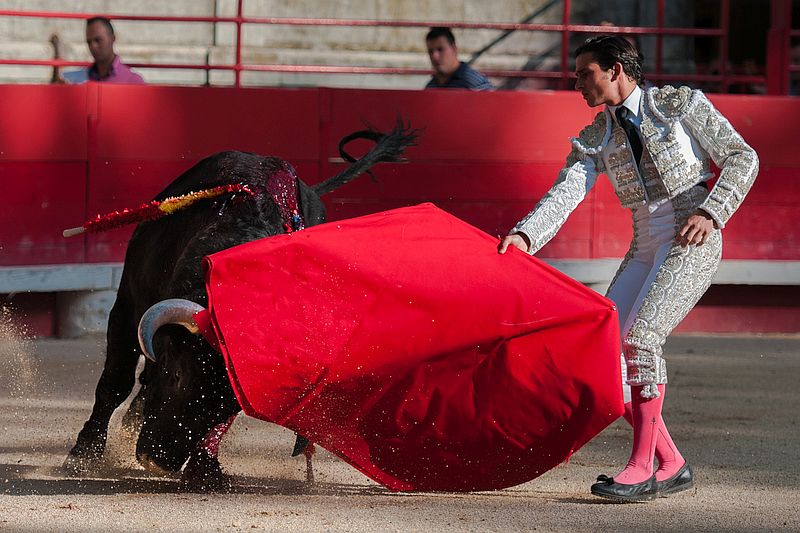Part 1: Canal du Rhône à Sète – An Overview
The Canal du Rhône à Sète passes through flat marshland that borders the wilderness area of the Camargue. Its route is a short distance inland from the coast and its beaches. Work on this link between the Étang de Thau near Sète and the River Rhône at Beaucaire did not begin until the 17th century. A hundred years passed before a canal extending all the way to the Rhône was completed in 1808.
Part 2: Towns & Villages
Frontignan is a small fishing village surrounded by the Gardiole hills to the north, the Ingril lagoon in the east, the Étang de Thau in the west and the Mediterranean shore to the south. The village is famous for its sweet white wine, Muscatel, which is made solely with the Muscat grape. The Muscat de Frontignan Appellation is one of the oldest AOCs in France. According to legend, when Hercules passed through Frontignan, he twisted the bottle in order to squeeze out the last drop, giving it its unusual shape.
Built between the 12th and the 14th centuries, the Eglise de la Conversion de Saint Paul is one of the most beautiful fortified churches in the Languedoc. The gate is adorned with a frieze of fish and boat motifs, in honour of the once important seaport of Frontignan La Peyrade. Located in the former 16th century Chapelle des Pénitents, with its finely carved 17th century doorway, is the museum of local history.
The former Cathedral of St-Peter and St-Paul de Maguelone stands abandoned on an isthmus between the Étang de l’Arnel and the Mediterranean Sea on the site of the ancient city of Maguelone. Once the episcopal seat of the Bishop of Maguelone, the Cathedral was built in the 11th century in the Romanesque style. Due to its prominent location next to the water’s edge, it was fortified. Although parts such as its towers and turrets have since been demolished, the main body of the building remains and is used for both religious and secular purposes. A must visit if you are cruising on the Canal du Rhône à Sète
Palavas-les-Flots was established as a customs fort and a fishing village late in the 18th century. From the beginning of the 19th century, local and seasonal tourists were drawn to the village and in 1872, when a local train to and from Montpellier started service, seaside tourism reached an all-time high. The train operated until 1968.
Aigues-Mortes, established in 1240 by (Saint) Louis IX, was built in the form of a square surrounded by stone ramparts. Its name literally translates to “Stagnant Waters”, derives from the tidal salt flats on which the town sits. At low tide, there are pools of grey and brown, and when the waters rise – wet marshland surrounds the city.
Today Aigues-Mortes is a perfectly preserved Provençal town, a miniature fortress with crenelated walls and streets laid out in a grid. With 10 gates and 14 towers, including the 108-foot-high Tour de Constance, it feels very much like a smaller version of Carcassonne. Although it was once a major port, it is now marooned three miles from the sea. However, it does stand on four navigable canals including the Canal du Rhône à Sète
Gallician is a small village located in the Petite Camargue at the foot of the Costières plateau near the Canal du Rhône à Sète With a population of approximately 1,000 inhabitants, Gallician’s economy is driven primarily from viticulture in the AOC Costière-de-Nîmes, fishing and “sagne” – the cutting of reeds.
St-Gilles owes its name to the abbot Gilles l’Ermite, whose tomb was one of the most important pilgrimage sites in Christendom in the 12th century. Originally on the route between Bordeaux and Jerusalem, and later on the route to Santiago de Compostela, Saint-Gilles was once a port used by merchants, pilgrims and crusaders and by the 11th century its wealth was reflected in the creation of its own currency. Soon after, the great priory of the Order of St John of Jerusalem was founded here, where the seat remained until it was transferred to Arles in 1615.
In 1208 a friend of Pope Innocent III travelled the region to try to stem the Cathar heresy in the south of France but was murdered by Cathar supporters. It was, in part, due to his death that Pope Innocent III launched the call to the Crusade Against the Albigensians, or Cathars. In the thirteenth century, Saint-Gilles strengthened its religious credentials as the birthplace of Pope Clement IV.
Throughout the Middle Ages, the wines from this terroir were considered equal to those of Beaune and were produced with the Mourvèdre grape variety, sometimes still referred to as the “Plant of Saint-Gilles”.
In the centre of the town is the UNESCO 12th century Abbey of Saint-Gilles. The former abbey retains parts of its cloister buildings, the former cellar and on its eastern façade three ornamental gates. The abbey church houses the tomb of Saint Gilles. The present high church was built in the 17th and 18th centuries after the ravages of the Wars of Religion.
The ancient commune of Bellegarde lies between the Canal du Rhône à Sète and the River Rhône. A 22m Roman aqueduct dating from the second half of the first century AD bears witness to human activity in the area during the Gallo-Roman period. The aqueduct supplied water to the city of Arles.
In the 12th century, the Priory of Saint Vincent de Broussan was built close to the village, on one of the routes to Santiago de Compostela. The original buildings, unfortunately, have not been fully preserved. The chapel, dedicated to Vincent de Zaragoza, the patron saint of the winemaker, remained a place of worship until 1926. The chapel and the main remaining premises are currently private property. In 2011 the site underwent a comprehensive restoration programme and today guided tours of the priory are offered in association with the tourism office.
Founded in the 7th century BC, Beaucaire was known as a relay town of the Via Domitia that connected Italy to Spain and started a reputation as a trade town that was to last nearly 2000 years. It is at this stage of the route, that the Via Domitia divides to serve the towns of Arles, Nîmes, Remoulins and Saint-Gilles.
The continued extension of the city began to slow in The Middle Ages. Beaucaire saw invasions from the Burgundians, Visigoths and then the Saracens. It was after these attacks that the first ramparts were built, and the extension of the castle was carried out.
The city took its name, Beaucaire, meaning beautiful stone, in reference to its many elegant buildings and the quarries in the hills that surround it. Simon de Montfort tried to besiege the city in 1216 during the Albigensian Crusade but was unable to take it. In the 13th century, Saint louis frequently visited Beaucaire, during which time its population and infrastructure was expanding. Despite the Hundred Years War and the Wars of Religion, during which the town was a Huguenot stronghold, the splendour and sophistication of the city’s architecture grew, along with the wealth of its merchants.
From the 17th – 18th centuries, the Fair of the Madeleine brought Beaucaire international fame. The 10-day trade fair attracting merchants from all around the Mediterranean reportedly generated as much business as the port of Marseille received in one year. During the French Revolution, the most beautiful mansions and residences were built, including the Hôtel de Clausonnette and the Hôtel de Ville. With the advent of the railways, Beaucaire’s importance declined but the Fair of the Madeleine still exists today, albeit in the form of carnivals, bull races, and various festivities. Towards the end of the 19th and the start of the 20th century, the Canal du Rhône à Sète was dug, connecting Beaucaire with the Canal du Midi and ultimately with Bordeaux.
 English
English
 Spanish
Spanish French
French German
German Norwegian
Norwegian Portuguese
Portuguese Swedish
Swedish Italian
Italian Russian
Russian Simplified Chinese
Simplified Chinese Japanese
Japanese


